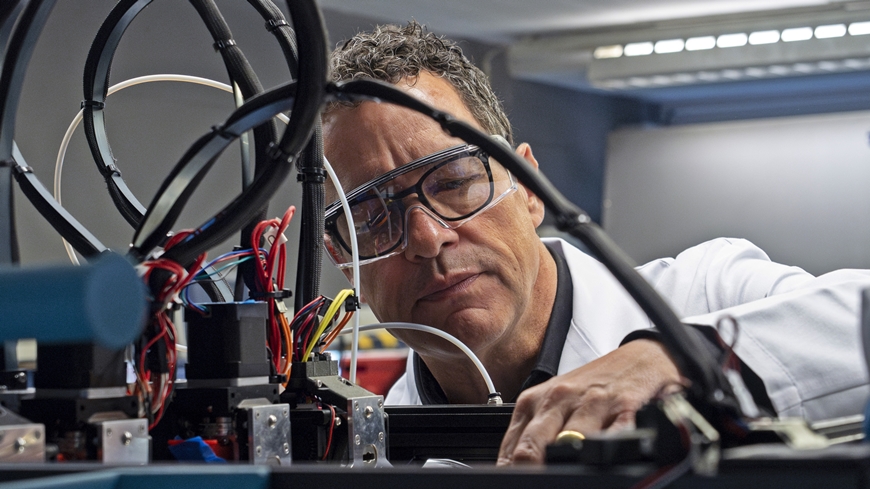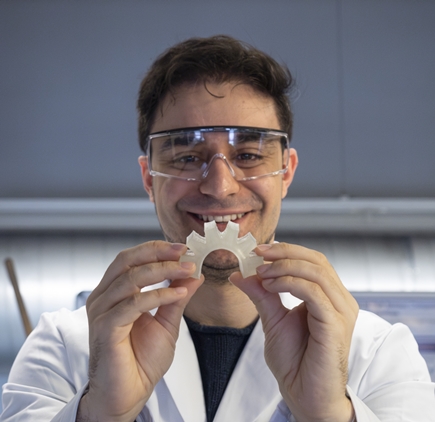Soft robotics
Sensitive ceramics
Robots that can sense touch and perceive temperature differences? An unexpected material might just make this a reality. At Empa's Laboratory for High-Performance Ceramics, researchers are developing soft and intelligent sensor materials based on ceramic particles.

Most people think of coffee cups, bathroom tiles or flower pots when they hear the word "ceramic". Not so Frank Clemens. For the research group leader in Empa's Laboratory for High-Performance Ceramics, ceramics can conduct electricity, be intelligent, and even feel. Together with his team, Clemens is developing soft sensor materials based on ceramics. Such sensors can "feel" temperature, strain, pressure or humidity, for instance, which makes them interesting for use in medicine, but also in the field of soft robotics.
Soft ceramics – how is that supposed to work? Materials scientists like Clemens define ceramics as an inorganic, non-metallic material that is produced from a collection of loose particles in a high-temperature process known as sintering. The composition of ceramics can vary – and their properties change as a result. But earthenware and porcelain are nowhere to be seen in Clemens' lab. The researchers work with materials such as potassium sodium niobate and zinc oxide, but also with carbon particles.
None of these materials are soft. In order to fashion them into flexible sensors, the researchers embed ceramic particles in stretchable plastics. "We work with so-called highly filled systems," says Clemens. "We take a matrix made of a thermoplastic and fill it with as many ceramic particles as possible without compromising the elasticity of the matrix." If this highly filled matrix is then stretched, compressed or exposed to temperature fluctuations, the distance between the ceramic particles changes, and with it the electrical conductivity of the sensor. It's not necessary to fill the entire matrix with ceramic, emphasizes Clemens: Using 3D printing, the researchers can also embed the ceramic sensors as a kind of "nerves" in flexible components.
Selective and intelligent

The production of soft ceramic sensors is not trivial. Usually, soft sensors are sensitive to different environmental influences at the same time, such as temperature, strain and humidity. "If you want to use them in practice, you need to know what you are measuring," says Clemens. His research group has succeeded in producing soft sensors that react very selectively only to pressure or only to temperature. The researchers integrated these sensors into a prosthetic hand. The prosthesis "senses" the flexion of its fingers and notices when it touches a hot surface. Such "sensitivity" would be an advantage both for robotic gripping tools and for human prostheses.
The Empa team even went one step further with the development of a soft "robot skin". Similar to human skin, the multi-layered plastic skin reacts to touch and temperature differences. In order to evaluate the complex data, the Empa researchers developed an AI model together with researchers from the University of Cambridge and trained it using data from around 4,500 measurements. This is also reminiscent of human perception, as the nerve impulses from our skin are evaluated and extrapolated in the brain.
Safe collaboration between humans and machines
The aim, says Frank Clemens, is for humans and machines to work together safely and harmoniously. "Today's robotic systems are big, clunky and very strong. They can be dangerous for humans," explains the researcher. If in future we are to increasingly share our workplaces with robots, they should react quickly and sensitively to touch. "If you accidentally touch another person, you automatically pull away," says Clemens. "We want to give robots the same reflex." The researchers are now looking for industrial partners in the field of robotic gripping systems. But soft sensors are also in demand in medicine – the team recently completed an Innosuisse project with the company IDUN Technologies, in which they produced flexible electrodes for brain wave measurements.
The work is far from over: The researchers want to make their soft ceramic sensors even more sensitive and intelligent. This involves combining new ceramic materials and soft polymers and optimizing their sensor properties. The secret to success lies in the interaction of these two components.
Dr. Frank Clemens
High-Performance-Ceramics
Phone +41 58 765 4821
Anna Ettlin
Communications
Phone +41 58 765 4733
redaktion@empa.ch
Open Lab Day
On September 14, 2024, Empa Dübendorf will open the doors of its laboratories to the public. At over 70 stations, visitors will be able to experience current Empa research live on topics such as climate change, the energy transition, human and environmental health and much more. The stories in this issue give a small taste of the variety of materials and technologies that are discovered, researched, and developed in Empa's laboratories. Hungry for more? Visit us on September 14!
Read the latest EmpaQuarterly online or download the PDF version.
-
Share







